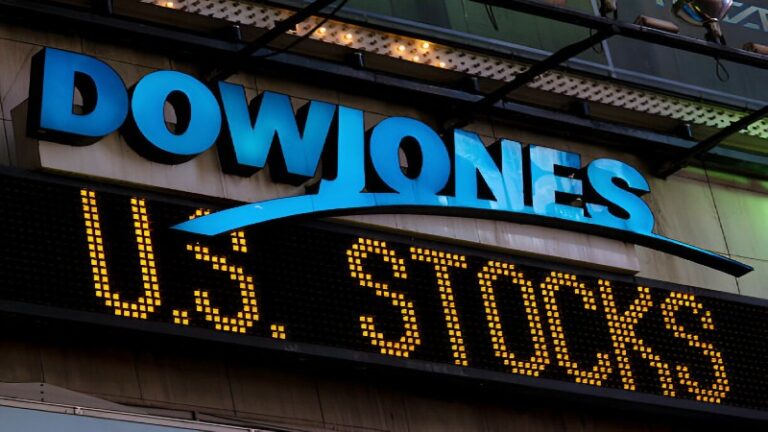What is INDEXDJX: .DJI?
INDEXDJX: .DJI represents the Dow Jones Industrial Average on financial data platforms. It tracks the performance of 30 major publicly traded U.S. companies, often referred to as blue-chip stocks. These firms come from a wide array of sectors, symbolizing the broader U.S. economic health.
Quick Stats (as of July 2025)
| Current Value | 44,379.28 |
|---|---|
| 52-Week High | 45,073.63 |
| 52-Week Low | 36,611.78 |
| YTD Change | +4.23% |
| 1-Year Change | +12.62% |
The Price-Weighted Methodology
Unlike market-cap weighted indices like the S&P 500, the Dow uses a price-weighted system. This means that stocks with higher share prices exert more influence on the index’s movement—even if the company itself isn’t the largest by market cap.
Example
If Company A trades at $500 and Company B trades at $50, a 1% move in Company A affects the index 10 times more than a 1% move in Company B.
The Dow Divisor
To maintain continuity, a figure called the Dow Divisor is used. As of May 2025, this divisor is approximately 0.15. This divisor adjusts for stock splits, dividends, and index composition changes.
Who Decides What Companies Are Included?
The index’s components are selected by a committee made up of the Wall Street Journal editor and members from S&P Dow Jones Indices. They assess companies based on:
- Reputation and history
- Industry relevance
- Investor interest
- Sector balance in the index
Sector Diversity Within the Dow
The Dow is not confined to industrial stocks, despite its name. It includes companies across technology, healthcare, finance, and consumer goods. Here’s a look at some current heavyweights:
| Company | Sector |
|---|---|
| Microsoft (MSFT) | Technology |
| Apple (AAPL) | Technology |
| UnitedHealth (UNH) | Healthcare |
| Goldman Sachs (GS) | Financials |
| Home Depot (HD) | Consumer Goods |
Misconceptions About the Dow
Despite its fame, the Dow is often misunderstood. Here are common misconceptions:
- It reflects the whole market – Not entirely. It covers only 30 stocks, missing out on mid- and small-cap sectors.
- Bigger companies move the Dow more – Not always. It’s about share price, not market capitalization.
- It’s outdated – While the price-weighted method has limitations, the Dow still offers valuable market insights.
The Dow as a Sentiment Barometer
Beyond its mathematical makeup, the Dow acts as a real-time sentiment indicator. Because of its high visibility, major movements in the Dow are closely followed by investors, media, and policymakers alike.
For example
When the Dow dropped 500 points following a surprise tariff announcement from President Trump in July 2025, it reflected immediate investor anxiety—not just valuation shifts.
Why the Dow Still Matters in 2025 and Beyond
Despite being over 125 years old, the Dow still holds relevance:
- Media Attention: Often cited in headlines and breaking news.
- Investor Psychology: Reaching or breaching milestones like 40,000 can drive sentiment.
- Historical Benchmarking: Useful for comparing past market performance.
Real-Time Tracking Tools
To track the Dow live:
- Use platforms like TradingView or Yahoo Finance.
- Most free charts update every 15 minutes; for real-time quotes, services like Bloomberg Terminal are needed
Conclusion
INDEXDJX: .DJI remains more than just a number—it’s a lens through which we view economic confidence, sectoral leadership, and investor psychology. While it’s not perfect, its history, simplicity, and visibility give it unmatched significance. In a rapidly digitizing financial world, the Dow serves as both a legacy metric and a modern market signal.
Frequently Asked Questions (FAQs)
What is INDEXDJX: .DJI?
INDEXDJX: .DJI is the ticker symbol for the Dow Jones Industrial Average on financial platforms. It tracks 30 major U.S. companies as a measure of stock market performance.
How is the Dow Jones calculated?
The Dow is a price-weighted index, meaning companies with higher stock prices have a larger impact on the index than lower-priced stocks. A special divisor adjusts for stock splits and changes in the index composition.
Why does the Dow use a price-weighted formula?
Charles Dow originally created the index using a simple average of stock prices in 1896. That method evolved into today’s price-weighted system, where stock price—not company size—determines weight.
Which companies are in the Dow Jones Industrial Average?
The Dow includes 30 large U.S. companies such as Apple, Microsoft, UnitedHealth Group, Visa, and Johnson & Johnson. The list changes as the economy evolves.
Is INDEXDJX: .DJI updated in real time?
Yes, the Dow updates every few seconds during trading hours. However, most free platforms like Yahoo Finance or TradingView delay the feed by 15 minutes unless you use a premium service.
How often is the Dow Jones index rebalanced?
There’s no fixed schedule. The committee behind the Dow reviews and updates components on an as-needed basis, based on mergers, stock splits, or sector relevance.
Is the Dow still relevant compared to the S&P 500?
Yes, the Dow is widely followed and reflects market sentiment, though it only includes 30 stocks. The S&P 500 offers broader exposure, but the Dow remains a trusted historical benchmark.
Enjoyed this? Share this post with fellow fans and influencers, and be sure to check back regularly for the latest updates, insights, and news on all things simpcity!

